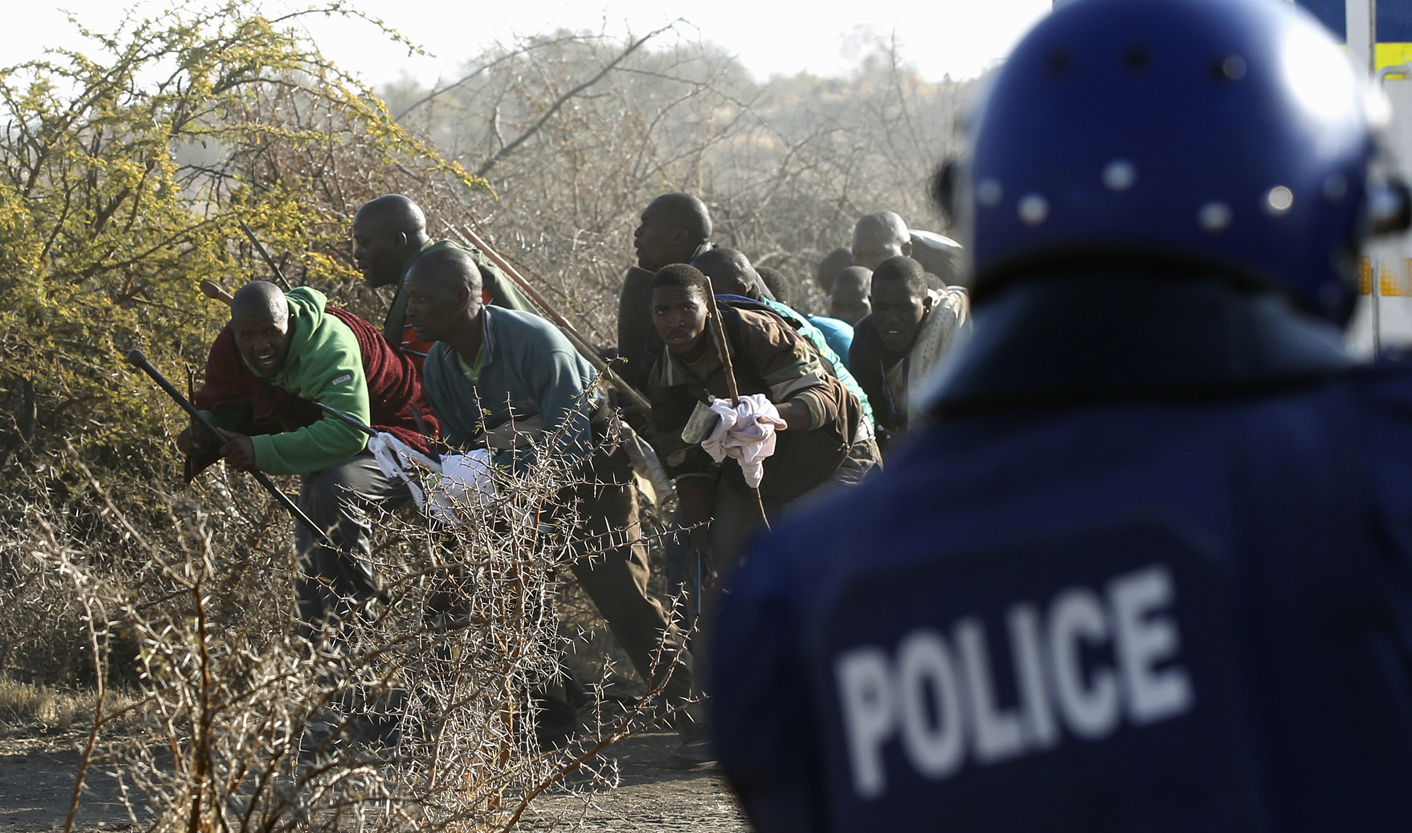“In scenes that evoked memories of some of the country’s darkest days, national television showed pictures of police in helmets and body armour shooting at workers on Thursday amid shouting, panic and clouds of dust at Lonmin's Marikana platinum mine,” wrote David Smith and Terry Macalister for The Guardian in one of the many global news stories on SA’s Lonmin massacre that evoked the metaphorical ghost of apartheid past.
A battery of boys in blue, weapons to the ready, facing a dusty outcrop of protestors, teargas flying and then the inevitable rat-a-tat-tat of the live rounds that mows down the strikers. This was an image that was seared into the mind of the world during South Africa’s Apartheid regime and remains lurking, ready for the recall. Only this time the easy and obvious analogy instantly positions the police and South Africa’s government as the bad guys, and the miners as the victims.
It was an easy reach for international news. Foreign Policy couldn’t resist reducing what happened at Lonmin to a reductive metaphor. “In one of the bloodiest police operations since the end of Apartheid, heavily armed South African police officers shot and killed 34 miners at a wildcat strike about 62 miles north of Johannesburg.”
“Lonmin massacre evokes Soweto and apartheid brutality” wrote Sibongile Khumalo for Agence France-Presse (AFP). “South Africans believed police massacres were for the history books and museums, but around Soweto's Hector Pieterson Memorial the killing of 34 miners stirred dark memories and new worries,” Khumalo noted in a story that surveyed Soweto locals about their perceptions of the Marikana massacre.
“In Soweto’s 1976 uprising, honoured at this memorial, white apartheid police gunned down black students demanding a better education in a protest that left 23 dead the first day, and sparked a national uprising. On Thursday at Lonmin's Marikana platinum mine, 34 workers were shot dead in a clash with police as they demanded better wages in a wildcat strike,” Khumalo wrote before asking locals for their reactions, most of which speak about a new divide: the class divide.
“I have no doubt that the police wouldn't have dared shoot at a group of rich white workers,” an unemployed 27-year-old told AFP. “Most of us expected freedom to deliver us from social injustices and poverty. But what we see is more suffering by the poor and the capitalists keep getting richer,” said Thozamile Ngesi, a visitor to the Hector Pieterson Memorial. “I guess we are now going to see memorials of post-apartheid police massacres. The blood of poor black people continues to flow,” said Soweto local Ananias Makgaretsa.
The Apartheid metaphor is easy, precisely because of the class divide in South Africa which has heralded a new separateness. In South Africa the new “apartheid” is the distance between the poor, the working class and the political elite with their strong connections to mining and mineral wealth which together create a top stratum of the super-rich and powerful.
Amongst these ANC heavyweights is Cyril Ramaphosa, whose Shanduka holds a 50.03% share of Incwala Resources, which holds 18% in two of Lonmin plc’s local subsidiaries.
Analysts think the action at Lonmin is going to cast a long shadow over SA’s mining sector. Africa analyst Mark Rosenberg told CNN the Lonmin massacre (the bloody outcome of union wage negotiations with mine management) had set a “problematic precedent for platinum companies in South Africa.”
Rosenberg said the National Union of Mineworkers (NUM) was a close ally to the ANC and that its inability to quell the violence at Marikana would have a drag on Zuma. In particular, the Lonmin violence would impact the president’s bid for re-election, which Rosenberg predicted is “significantly less likely”.
People are no longer willing to sit and wait around for the ANC to deliver, Rosenberg told CNN. “They are becoming more and more impatient and they're becoming more and more violent as a result.”
Reuters also pointed out the close relationship between NUM and the ANC, saying the mineworkers union was “the country's biggest union that has been a training ground for ANC leadership and a staunch supporter of President Jacob Zuma.” The financial newswire then quoted Lazarus Letsoele, a striking miner from the Lonmin Marikana mine who escaped when police opened fire last week.
“The NUM is all about politics. They have forgotten about the man in the mine shaft,” Letsoele told Reuters which said the Marikana mine massacre will “wound the ruling ANC and its main labour ally, laying bare workers’ anger over enduring inequalities in Africa's biggest economy.”
Reuters continued: “Thursday’s shooting, bringing back memories of Apartheid-era violence, underlined that after 18 years in power the African National Congress and its union partner have not been able to heal the fissures of income disparity, poverty and joblessness scarring the country.” DM
Read more:
- Mine shootings expose South Africa’s angry underbelly by Justice Malala on Gulf News
- Lonmin mining massacre shocks investors with flashback to Apartheid South Africa in The Telegraph
- Historic Lonmin faces “perfect storm” after killings in Reuters
Photo: A policeman (R) fires at protesting miners outside a South African mine in Rustenburg, 100 km (62 miles) northwest of Johannesburg, August 16, 2012. South African police opened fire on Thursday against thousands of striking miners armed with machetes and sticks at Lonmin's Marikana platinum mine, leaving several bloodied corpses lying on the ground. A Reuters cameraman said he saw at least seven bodies after the shooting, which occurred when police laying out barricades of barbed wire were outflanked by some of an estimated 3,000 miners massed on a rocky outcrop near the mine, 100 km (60 miles) northwest of Johannesburg. REUTERS/Siphiwe Sibeko




